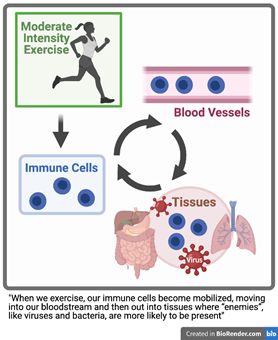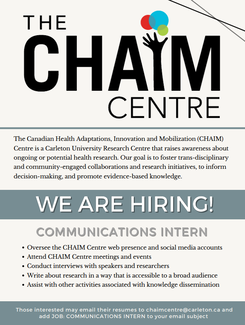 Out for a run. PC: Zoë Williams Out for a run. PC: Zoë Williams By Zoë Williams, Carleton University Student-Athlete I tie up my running shoes and head out the door. Gravel crunches underfoot. A song by Taylor Swift plays through my earbuds. Wind brushes against my face as I run. I breathe deeply and look around, enjoying the outdoors on this fresh and sunny spring day. Exercise. What comes to mind when you think of the word? With gyms closed and physical distancing rules in place I’d bet your definition has changed and that your daily physical activity levels have changed too. Moving from school or the office to working from home has meant that walking to work, class, or the coffee shop, has been replaced with walking downstairs, to the home office (if you’re lucky enough to not be working in your bedroom!), and into the kitchen. Research findings suggest that COVID-19 has changed our exercise and activity patterns, with some people exercising more, others less, and a worldwide study reporting a decrease in daily step counts that corresponded with the first wave of the pandemic (1). A large survey in the UK also reports that fewer people are staying active in the second lockdown. As we move in and out of various stages of lockdown across the country, Canadians may also be struggling with the motivation to stay active. Yet, exercise may actually be one of the best things a person can be doing for their immune system in the midst of a global pandemic!  Hippocrates, a Greek physician who’s considered the father of medicine, is quoted to have said “walking is man’s best medicine”. Based on the evidence, he may have been onto something. Our immune system is comprised of a large array of cells and molecules (check out this video for an immune system refresher) and research findings indicate that moderate intensity exercise can boost our immune system. One of the ways that exercise does this is by increasing the surveillance of our immune cells. When we exercise, our immune cells become mobilized, moving into our bloodstream and then out into tissues where “enemies”, like viruses and bacteria, are more likely to be present (2). If our immune system is our army, you can think of exercise as a signal – moving our army from its barracks and out into the field, telling it to be on high alert for enemies. This means that when we exercise our immune system may be more prepared to detect and respond to potential enemies that enter our body. Although no research has yet examined the effect of exercise on resistance to or severity of COVID-19, studies have reported that exercise can reduce the risk, duration, and symptom intensity of other viral infections. Exercise has also been shown to improve response to vaccinations in older adults by increasing the vaccination effect and reducing side effects (3).  PC: Andrey Armyagov – Shutterstock PC: Andrey Armyagov – Shutterstock However, in these pandemic times we’re not just facing a virus, but many people are also facing confinement and isolation that comes with lockdowns and quarantines. How may exercise interact with that and the immune system? A recent study examining the effects of exercise on astronaut immune health gives us a look at the interaction between exercise, the immune system, and the stress of isolation. Astronauts tend to experience a weakened immune system during space travel, which is thought to be connected to the stress that comes with isolation and confinement. Researchers found that lower cardiorespiratory fitness during space travel was associated with a weakened immune system, but higher levels of fitness were shown to be protective against this weakening. Although most of us are not astronauts, we are facing increased levels of confinement and isolation and this study shows us that exercise may allow our immune system to cope with the added stress (for more information on stress and exercise, check out this blog!).  Working out from home. PC: Fottograff iStock Photos Working out from home. PC: Fottograff iStock Photos You may be wondering what types of exercise we should do for these immune boosting effects. More research needs to be done before we know the specifics, but if you’re an elite athlete or a lover of multi-hour high intense exercise then I recommend you check out this podcast. For most of us, simply getting up and moving at a moderate intensity is key. Moderate intensity exercise can be defined as exercise at 60% of heart rate reserve (which is 65-75% of one’s max heart rate) for a max of 60 min. For example, a 30-60 min. brisk walk. The World Health Organization recommends that adults reduce sedentary time, engage in 150-300 minutes of moderate intensity exercise a week and strength training activities at least twice a week, but that this can be adjusted based on fitness level. It may look like a lot, but this is only 20-30 min. of exercise a day! However, if you haven’t exercised before, check out these articles, and make sure to build into it; rapid increases in exercise have been reported to increase the risk of injury (4), but starting at a low intensity and gradually building from there can prevent exercise related injuries, and doing a variety of different types of physical activity may also reduce injury risk (5). For those of us in Ottawa, we are lucky to have the Rideau Canal for skating and a wonderful network of cross country ski, biking, and hiking trails to explore! So, lace up your shoes, buckle up your ski boots, roll out your yoga mat, and get moving! Your immune system will thank you. References:
1 Comment
 We are currently seeking a a part-time Communications Intern to support our knowledge translation activities and manage our web presence over the summer! Carleton students with journalism and social media expertise are encouraged to apply. Candidates can send their CV and covering details to [email protected]. For a full job description, click here! By Jennifer Vorobej, 4th-Year Neuroscience and Mental Health Student
|
Archives
March 2023
Categories
All
|




 RSS Feed
RSS Feed